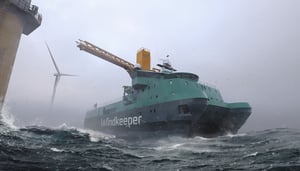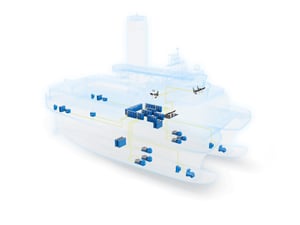
Setting the standard for energy efficiency in offshore windSetting the standard for energy efficiency in offshore wind
With its compact energy design and advanced redundancy, Windkeeper sets new standards in offshore wind operations. NES’ tailored energy solution ensures the vessel meets demanding DP requirements while enabling battery-powered, low-emission operations.
The offshore wind industry requires energy-efficient vessels capable of precise operations in challenging environments.
To meet these demands, GC Rieber Shipping developed Windkeeper – a service operation vessel (SOV) designed for wind farm maintenance. With its innovative SWATH (Small Waterplane Area Twin Hull) design, the vessel minimises motion, providing unparalleled technician comfort and operational reliability.
NES was tasked with delivering a fully integrated energy solution to ensure redundancy, safety, and efficiency while supporting future-ready emission goals.
Tailored energy and control systems
NES provides a complete suite of smart control and power systems tailored to Windkeeper’s unique requirements. Central to the design are the Quadro Master DC switchboards and Odin’s Eye bus-tie technology, forming a fully redundant, ring-based DC power system. This setup enhances certified closed DC ring DP2 operation and optimizes energy management during dynamic positioning, thereby reducing fuel consumption and operational costs.
The hybrid propulsion system includes batteries, shore connection, and offshore connection, enabling fully electric in-field operations when infrastructure allows it. By reducing daily fuel consumption to just 2.7 tonnes and significantly lowering emissions, the system sets a new benchmark for sustainable offshore operations.

Precision with Raven INS
Windkeeper’s navigation is enhanced by our Raven Integrated Navigation System (INS), designed to simplify operations and improve decision-making. By consolidating radar, ECDIS, and AIS data into a single interface, the system provides a clear, comprehensive view for safe and precise navigation. This seamless integration reduces the workload on the bridge, allowing the crew to focus on efficient vessel operation, especially in a dynamic and demanding offshore environment.
Collaboration driving innovation
NES’s tailored solutions demonstrate how cutting-edge energy systems can address the challenges of offshore wind operations. These advancements directly translate into operational and environmental savings.
"Windkeeper will reduce charterers’ daily costs and emissions significantly, enhancing their environmental footprint," says Christoffer Knudsen, CCO at GC Rieber Shipping.
With its Charge2Work capability, the vessel is primed for zero-emission operations in the future, combining stability and efficiency to redefine offshore wind logistics.
"We believe Windkeeper will be a preferred alternative for this decade," Knudsen adds, underscoring the vessel's role in shaping the future of offshore wind solutions.
A blueprint for a greener future
Windkeeper’s compact design and advanced systems exemplify a forward-thinking approach to offshore wind maintenance. The collaboration between NES and GC Rieber Shipping highlights how precise engineering for specific operations can meet the sector’s evolving demands.
As the offshore wind market expands, Windkeeper serves as a model for sustainable innovation, demonstrating how tailored solutions can enable greener and more cost-effective maritime logistics.
